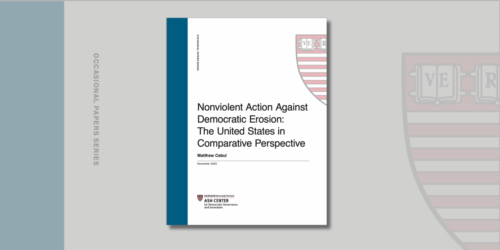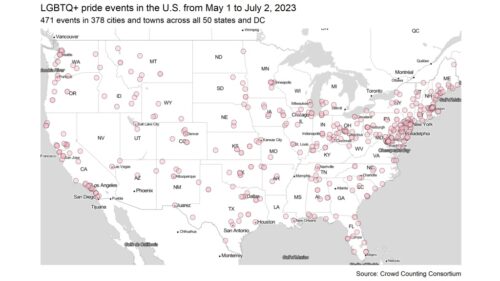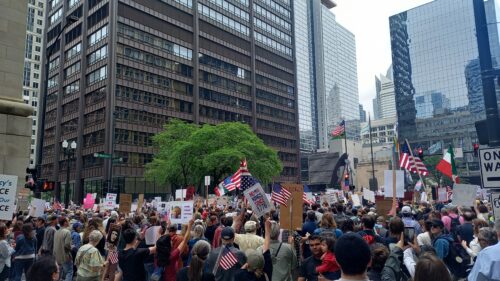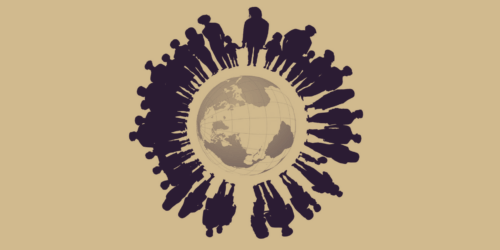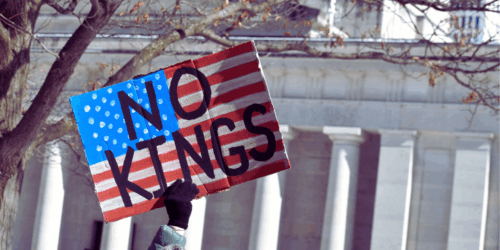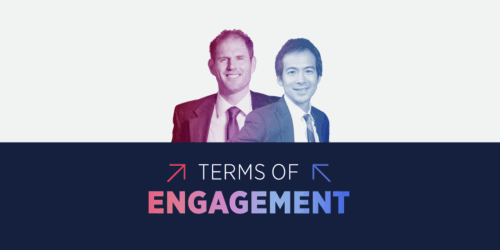After a year that saw historic levels of anti-LGBTQ+ protest activity, legislative action, and online jawboning, millions of people turned out in May and June 2023 for hundreds of LGBTQ+ pride celebrations across all 50 U.S. states and the District of Columbia.
Specifically, Crowd Counting Consortium (CCC) has logged more than 470 LGBTQ+ pride marches, rallies, festivals, parades, and even bike rides since the start of May 2023 through the first weekend of July, and we continue to add others as our research process uncovers them. So far, we only have estimates of crowd sizes for 158 of those events, or about one-third of them. Across just those 158 events, though, we tallied nearly 5.9 million participants, give or take a million and a half. Seven of the 10 largest pride events in the U.S. this year fell on the last weekend in June, the traditional peak of pride season, and they spanned the entire country: from New York City on the East Coast to Seattle and San Francisco out west, and from Houston and St. Petersburg down south all the way up to Chicago via Denver, Columbus, and St. Louis.*
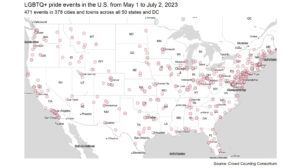
Across those more than 470 events, we only saw reports of counter-protests at 67 of them, or about 14 percent. We expect that some additional fraction also involved counter-protests that weren’t reported by our sources, but the fact that they weren’t reported implies that those actions were probably small or otherwise not particularly noteworthy.
Of the 67 pride celebrations where counter-protests were reported by our sources, 19 of those counters, or about 28 percent, involved white supremacists and other far-right groups. Of those 19, only four involved Proud Boys, the group that had reportedly threatened on social media to turn Pride Month into Proud Month. Five of the 67 counters involved Patriot Front; another five involved various chapters of White Lives Matter; and five more involved one or more Active Clubs. While these types of groups continue to protest outside drag shows and Drag Story Hours at historic rates, they did not make much of a splash at pride events in 2023.
A smattering of those 67 events saw counter-protests by more than one right-wing extremist group. Consistent with the larger theme of this post, though, the most violent clash we saw around all those several hundred pride events in the past 10 weeks was actually a brawl between two groups of far-right counter-protesters — the Proud Boys and the Rose City Nationalists — that happened blocks away from the targeted pride event in Oregon City, Oregon, on Saturday, June 24.
Meanwhile, we only saw reports of injured participants at two pride events in the past 10 weeks. The first occurred in Bozeman, Montana, on May 20, when a pride celebrant who engaged with a group of white-supremacist counter-protesters outside a Drag Story Hour at a local bookstore got pepper-sprayed and struck. The other occurred in Hot Springs, Arkansas, in early June, when a sign-holding counter-protester responded to parade-goers who approached and verbally confronted him by punching one of them in the face (and then getting arrested).
Over the past couple of years, a lot of folks — myself included — have focused on telling the story about how the right has ramped up its attacks on LGBTQ+ peoples’ equality and visibility, and how this sustained campaign is harming and even killing people. In a few posts on this blog, I’ve posted versions of the chart below, which shows how anti-LGBTQ+ protest activity has surged since mid-2022, and how that surge still shows no signs of abating. In fact, we can see from this updated version of the chart that anti-LGBTQ+ protest activity leapt to new heights during Pride Month, with more than 150 events in June 2023 alone. We also know that the hostile political climate led to the cancellation or relocation of some pride events or elements of them, and many others invested significant time and money in added security measures.
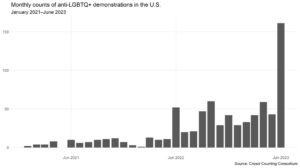
The threat summarized in that chart is urgent and dire, and while it’s vital that we keep sounding that alarm as long as the threat persists, it’s also important that we show how resilient and joyful queer people and their allies continue to be in the face of that incessant firehose of hostility and hate. So, here’s that same chart juxtaposed with one showing pro-LGBTQ+ protests, demonstrations, rallies, and the like over the same period. The monthly counts for LGBTQ+ rights and equality and liberation consistently dwarf the anti-LGBTQ+ ones, and as the latter have surged, so have the former.
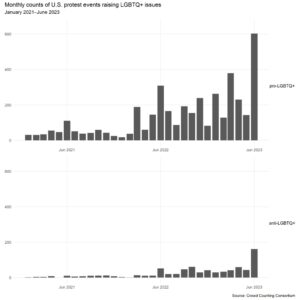
Finally, it’s also notable that, despite — or maybe because of? — the ongoing national wave of right-wing attacks on the queer community, the scope of American LGBTQ+ pride celebrations continues to expand. Of those more than 470 pride events we saw in the past 10 weeks, at least 22 were the first edition of what are meant to be annual events in their towns, and the reported crowd sizes at those first-ever events averaged in the several hundreds.
* CCC only tracks events that are free and open to the public and not solely organized by a local government or government agency. So, these tallies exclude festivals and shows that required paid tickets to enter, as well as flag-raising ceremonies, festivals, and parades exclusively organized by local or county governments. This post was originally published on July 3, 2023. This version was published on July 6, 2023, using updated CCC data that included more events.
